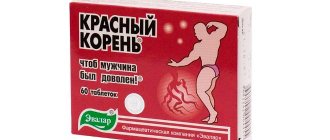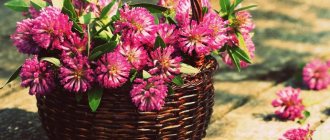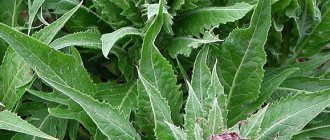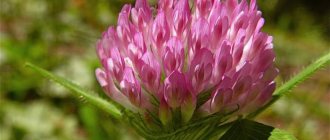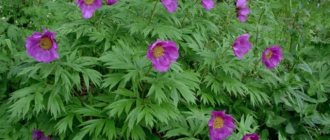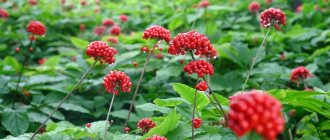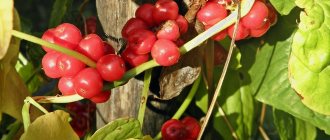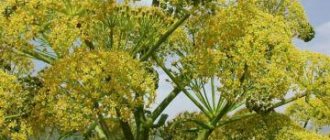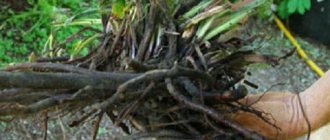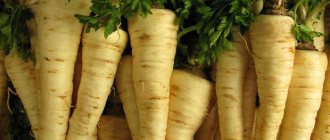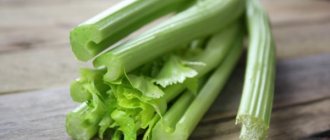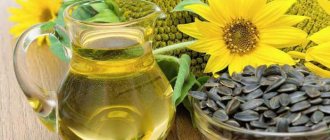1
12697
Author of the article
Evgeniy Nikolaevich Konoplev
Reading time: 4 minutes
AA
Traditional medicine copes with various diseases no worse than official pharmacology. The power of nature contained in plants and herbs heals the human body carefully and at the same time effectively. Currently, there are many drugs based on herbal ingredients. One of these remedies can be considered red root tincture for men. Altai healers have been making it since ancient times. The medicine helps the male body cope with prostatitis, impotence and other problems.
What does pennywort look like and where does it grow?
Redroot is a perennial plant belonging to the legume family. It got its name due to the similarity of individual parts of the beans to a coin. The kopek plant has a strong long stem, the height of which reaches 90 cm. It bears odd-pinnate leaves, divided into elongated blunt-pointed lobes. During the flowering period, the kopeck is covered with red, pinkish or white inflorescences. This process occurs from July to August.
The Altai region is considered the birthplace of the red root. Today the plant is found in the Urals, Siberia and the southern part of the Kola Peninsula. It can be found on forest edges, mountain slopes and meadows. The pennywort prefers well-drained soil located in elevated areas. Its distinctive features include the creation of favorable conditions for the growth of other plants. In total, there are about 100 species of pennyweed in nature.
The root of the pennywort goes into the ground to a depth of 5 m
Attention! Thanks to the content of catechin, kopeck is able to remove heavy metals from the body.
Chemical composition of red root
The healing properties of the red root are explained by its unique composition. It is represented by bioactive compounds. Among them are minerals, vitamins and organic acids. Due to this, the plant is in demand in alternative medicine. It contains the following elements:
- catechins;
- micro- and macroelements (zinc, iron, magnesium, calcium, strontium, potassium, selenium, calcium);
- tannins;
- ascorbic acid;
- saponins;
- estrogen;
- flavonoids;
- xanthones;
- coumarins.
We recommend reading: Why does the body need zinc, where it is found, daily requirement
Xanthones present in the red root stabilize the functions of the central nervous system. This helps eliminate the effects of stress and improve the quality of sleep. Estrogens are hormones necessary for the female body. Thanks to them, the penny can cope with gynecological diseases. Catechins protect the body from the harmful effects of radiation and promote its cleansing in case of poisoning with toxic substances.
Saponins, in turn, ensure the normalization of water-salt balance. Flavonoids help prevent the proliferation of malignant cells and strengthen blood vessels. Tannins normalize intestinal microflora and regulate stool. Ascorbic acid, present in red root in large quantities, activates the body's defense mechanisms.
Chemical composition
The benefits of red root are provided by bioactive compounds in the composition. Chemical analysis of the rhizome of the pennywort showed the concentration of the following substances:
- Estrogen is a steroid sex hormone produced by the ovarian follicles in women and the testicles in men. Responsible for the full development and functioning of the genital organs.
- Flavonoids are plant pigments that provide the rich color of the root. They improve the elasticity of red blood cells, slow down blood clotting, strengthen the walls of capillaries, and have antispasmodic properties.
- Catechins are substances that belong to the class of flavonoids. They have antitoxic and antitumor effects.
- Saponins are organic compounds that accelerate the penetration of proteins through cell membranes. They are diuretics and promote rapid absorption of drugs. They have an antisclerotic, antiulcer, laxative effect.
- Xanthones are powerful plant antioxidants. They prevent mutations in the DNA chain, are able to relieve inflammation, and have an antimicrobial and antitoxic effect. Strengthens the cardiovascular system.
- Tannins are astringent compounds that have disinfectant properties. They help eliminate diarrhea and normalize intestinal microflora.
- Coumarins are organic elements with antitumor activity. Strong anticoagulants, relieve spastic pain.
The red root contains ascorbic acid, as well as a number of macro and microelements:
- iron;
- magnesium;
- calcium;
- potassium;
- zinc;
- manganese;
- selenium;
- strontium, etc.
What cures and medicinal properties of red root
Since ancient times, kopeck has been used to replenish energy reserves. Residents of Altai prepare tea from it, which has a powerful tonic effect. The set of beneficial qualities of the plant makes it indispensable in folk medicine. Even bears prefer to recover from hibernation with a penny. It saturates the body with useful substances and slows down the aging process. The red root plant has the following medicinal properties:
We recommend reading: Mint tea: beneficial properties and contraindications, how to make
- antipyretic effect;
- antitumor effect;
- participation in the process of platelet formation;
- antioxidant effect;
- stimulation of kidney function;
- regulation of water-salt balance;
- expectorant effect;
- rejuvenating effect;
- strengthening the immune system.
Thanks to a lot of beneficial properties, red root helps cope with various diseases. It is often used as part of complex therapy. There are several medicinal forms of the plant - decoctions, tinctures, teas and infusions. Each of them has specific functions and nuances of application. Sometimes they are combined with each other. The main advantage of treatment with pennyweed is the low likelihood of side effects.
Red root effectively treats the following diseases:
- inflammatory process in the kidneys;
- cough;
- asthma and pneumonia;
- cardiovascular disorders;
- anemia;
- tuberculosis;
- nervous system disorders;
- gynecological diseases;
- ARVI and influenza;
- cystitis and pyelonephritis.
Substances in the red root increase capillary permeability and strengthen blood vessels
Important! When growing red root in a garden plot, you need to add a little soil from the plant’s natural habitat to the soil.
What are the benefits of red root for women?
Tea kopeck root is prescribed for women to solve gynecological problems. Its effectiveness is explained by its hormone content. Therefore, before treatment, it is extremely important to determine the level of estrogen in the blood through testing. Kopechnik is often used as an effective remedy for infertility. It has the ability to even out the menstrual cycle without causing hormonal imbalance.
Sometimes the red root is used to relieve pain in the mammary glands. In addition, it is considered a real elixir of youth. The substances contained in the plant promote skin rejuvenation and improve hair condition.
What are the benefits of red root for men?
The use of red root is indicated for men to combat erectile dysfunction. The plant stops the inflammatory process in the prostate and normalizes blood circulation. But we must remember that the effect is cumulative. Additional medications may be required. Kopechnik has the following effects on the male body:
- antioxidant effect;
- improvement of reproductive function;
- increased libido;
- tonic effect;
- increasing resistance to stress.
Beneficial properties of red root for children
In childhood, the correct use of red root is extremely necessary. It is strictly forbidden to exceed the permissible dosage, as this may cause side effects. For those under 12 years of age, alcohol-containing tinctures are prohibited. For treatment, it is better to use herbal tea. The main indications for the use of kopeck in children are immunodeficiency and colds.
Other medicinal properties of red root
Red root and anemia
The plant is used for blood diseases. In particular, its use is recommended for anemia of any etiology.
The antioxidant effect of red root helps cleanse the liver and blood. This corrects the composition of the blood, improves its parameters and maintains optimal hemoglobin levels.
Cleanses the blood and liver, maintains hemoglobin levels.
Red root and pressure
Tea pennywort has an excellent effect on the functioning of the heart, stimulating its work, thins the blood and reduces the likelihood of blood clots, and is therefore indicated for cardiovascular pathologies.
Normalizes blood pressure, stimulates blood circulation, tones the myocardium, makes it stronger.
Red root and lung diseases
Red kopeck - works well as an expectorant. It is an indispensable element of respiratory treatment courses. Therefore, using it together with the main treatment complex will be very justified: it reduces the frequency of coughing and removes the purulence of sputum.
It is worth remembering that the plant is a powerful immunostimulant. In addition, the perennial has proven itself to be an excellent pain reliever. It has an antitumor effect, and therefore is often used to treat cancer. Due to its composition, forgotten pennyweed has a beneficial effect on the health of the body as a whole.
Medicinal herbs in capsules from Jet Life
How to brew and use red root
The process of brewing red root is carried out according to a certain algorithm. There are several universal recipes. In each individual case, the concentration of active substances will vary. Accordingly, the effectiveness of therapy will change. The method of using pennywort should be chosen based on the nature of the disease.
Advice! Before using pennywort for medicinal purposes, it is advisable to consult a doctor.
Tea
Components:
- 500 ml water;
- 1 tbsp. l. chopped root;
- honey, cream - to taste.
Cooking process:
- The kopeck is poured into any container that retains heat well. Then it is filled with hot water.
- After 45 minutes of infusion, the drink is poured into cups.
- Cream and honey can be added directly to the cup.
You can use a French press to prepare pennywort tea.
Decoction
Ingredients:
- 1 tbsp. l. crushed pennyweed;
- 150 ml water.
Recipe:
- The raw materials are filled with water, after which the container is placed in a water bath.
- The liquid is heated for 20 minutes.
- After removing from the heat, the broth is infused under the lid for 2 hours.
- The drink is filtered before use.
Treatment with a decoction of pennywort is practiced for no more than 1 month.
Infusion
Ingredients:
- 1 liter of water;
- 2 tbsp. l. red root.
Cooking steps:
- The kopeck is poured into a thermos and filled with hot water.
- The medicine should be infused all night.
- In the morning, the liquid is filtered and taken in the required quantity.
The red root can be brewed without grinding it into a powder.
Alcohol tincture
Alcohol tincture of pennywort must be diluted with water before use. It is prohibited for use in case of liver and kidney diseases. In other cases, it can become a fairly effective means of folk treatment. Particularly effective against colds.
Components:
- 500 ml vodka;
- 50 g ground red root.
Cooking rules:
- Dry kopeck root is placed in a glass bottle and filled with vodka.
- The container is carefully sealed and stored in a dark place for 2 weeks.
- After the specified time, I filter the liquid through gauze or a special filter.
In the pharmacy you can find ready-made tincture of pennywort
Red Root Recipes
- Tincture for the treatment of tuberculosis, bronchitis and many other respiratory tract ailments, restoration of reproductive functions (both male and female), colds and infectious diseases. To prepare such a tincture, you need to add 50-60 g of pre-crushed plant roots to half a liter of vodka. You need to infuse for two weeks in a cool and dark place, shaking occasionally. After this, the tincture is filtered and taken 5-10 g three times a day. If you cannot take the tincture in its pure form, it can be diluted in a quarter glass of water and taken half an hour before meals.
- Red root tea. To prepare tea, you need to pour 1 tablespoon of crushed plant roots into a thermos and pour in a liter of boiling water. The tea should steep for at least 1 hour, after which it can be strained. It is recommended to take hot; it is permissible to add honey and milk to improve taste. This tea improves the functioning of the cardiovascular system, restores fluid balance in the body, improves blood circulation, strengthens and relieves fatigue.
How to brew and take red root for prostatitis
The red root is rich in zinc, magnesium and copper. They are extremely important for prostate diseases. Their main function is to stimulate seminal fluid and increase sexual desire. If the problem is caused by an infectious disease, then the pennyweed directs its effect on it. To get the desired effect, you need to properly brew the red root for men. To do this you will need the following components:
- 1 tsp. St. John's wort;
- 1 tsp. thyme;
- 2 tsp. penny;
- 1 tsp. oregano;
- 1 tsp. burdock root;
- 1 tsp. peony;
- 3 tbsp. water.
Cooking rules:
- All components are carefully mixed together and filled with water. It is simmered over low heat for half an hour.
- The finished drink is cooled to room temperature and then filtered.
- The decoction should be taken 1 tbsp. twice a day. During the period of exacerbation of the disease, the number of doses is increased up to 3 times. Treatment lasts at least 3 weeks.
After a course of treatment with a decoction of pennywort, it is necessary to undergo an ultrasound examination
No less effective against prostatitis is a tincture of pennywort with milk. But before using it, it is important to make sure there are no contraindications. The recipe uses the following components:
- 1 tbsp. l. red root;
- 500 ml water;
- honey and milk - to taste.
Recipe:
- The raw materials are poured into a container and filled with hot water.
- The duration of infusion is 2 hours.
- The milk is heated, then honey is added to it. The resulting drink is diluted with the infusion in a ratio of 1:3.
- Red root tincture for men in milk should be taken 2 times a day, 100 ml.
You can use absolutely any type of honey in the recipe.
Comment! Taking a decoction of pennywort for a long time normalizes a person’s psycho-emotional status.
How to take red root for weight loss
The main benefit of red root for the body is the regulation of metabolism. That is why it is often used for weight loss. Kopeknik promotes the removal of excess fluid and speeds up the process of digestion of food. For weight loss, alpine kopeck should be taken as part of tea. Drink the drink 1 tbsp. 3 times a day. To improve the taste, you can add honey to it. In addition to this, it is necessary to control the amount of calories consumed and exercise.
Beneficial properties of red root
This plant is of particular value because it contains a huge number of compounds that have P-vitamin activity. In terms of the number of these elements, the red root confidently ranks first among all known plants.
Even if you don't pay attention to the other beneficial components it contains, it is enough to help with many problems and ailments.
This plant has good anti-inflammatory, analgesic and antispasmodic properties.
It also has the ability to enhance diuresis, normalize the process of hematopoiesis and has a hemostatic effect. In addition, its beneficial effect has been noted in stimulating the functioning of the central nervous system.
It’s also interesting to read – Meadow clover (red): about flowers and grass, why it’s useful
The use of penny in cosmetology
The red root is common not only in folk medicine, but also in cosmetology. It is indicated for use by those with problematic and aging skin. A decoction of pennywort is often used instead of a cleansing lotion. Soak a cotton pad in it and wipe your face twice a day after washing.
Another effective remedy is a curd mask. It is a mixture of red root infusion and cottage cheese. The mask is applied to the face and left for 15-20 minutes. Then it is washed off with warm water. Regular use of the procedure makes the skin more elastic and eliminates fine wrinkles.
Contraindications
In addition to the indications for use, the red root herb also has contraindications. It is extremely important to take them into account in order to prevent possible side effects. Kopechnik is not recommended for use in the following cases:
- increased nervous excitability;
- persistent hypertension;
- high body temperature;
- allergic reaction;
- risk of developing myocardial infarction;
- pregnancy and breastfeeding;
- age under 12 years.
It is strictly forbidden to take red root together with antibiotics. This can increase their harmful effects on the body. If it is necessary to combine the plant with other drugs, it is important to consult a specialist. If an allergic reaction occurs, stop taking the medication immediately.
Collection and preparation of grass
The method and period for collecting pennyweed depends on what part of the plant is needed. The leaves are collected during the flowering period. They are simply torn off or cut off with a sharp knife. The root part is used at any time, but preferably in the fall, dug out with a shovel. Be sure to leave 1/3 of the system in the ground.
The collected raw materials are washed with running water. It can be crushed before drying. The roots and leaves are then spread out into the open, providing protection from direct sunlight. The drying time can vary from several hours to a day. The finished raw materials are stored in tin or glass jars with a lid. It is also acceptable to use paper bags for storage. It is necessary to keep the prepared raw materials away from moisture and sunlight. The shelf life of dried roots and herbs is 3 years.
Attention! Uncontrolled intake of red root derivatives can lead to nervous excitability.
Proper preparation will preserve the beneficial properties
The use of pennyweed has been known since ancient times. The leaves, stems, flowers and rhizomes of the plant are used for medicinal purposes. The upper part of the plant must be collected at the height of the flowering season, which is approximately July. The stem of the plant is cut and dried in the fresh air, under a canopy. This will protect the raw materials from rain, moisture accumulation and direct sunlight. The finished medicinal herb must be stored in a tightly closed container.
Important! For medicinal purposes, raw red root leaves are used. They can be stored in the refrigerator for no more than a month, after which they lose their healing properties.
Harvesting rhizomes of the pennywort must begin after its flowering period (end of August - September). Only mature plants that are well developed are suitable for medicine. It takes a lot of effort to dig a root out of the ground because it is deeply rooted. During the digging process, it is necessary to leave part of the rhizome in the ground, approximately 1/3. This place must be marked and raw materials must not be removed from it for 10 years. Over these years, the penny will be able to fully recover and regain all its healing properties. The dug up rhizome is cleaned of soil and other contamination. After which they must be thoroughly crushed and dried. Small roots can be left unchopped and dried whole. Dried raw materials must be stored in a well-ventilated area for no more than 3 years, then the roots lose their properties.
